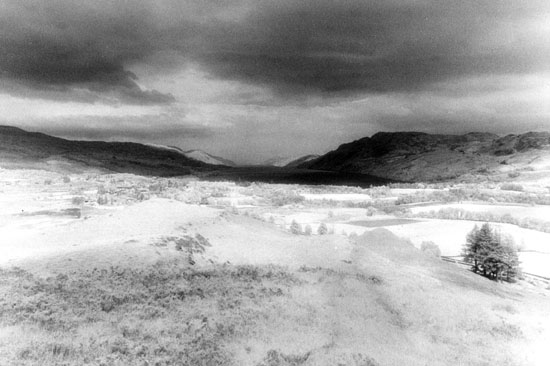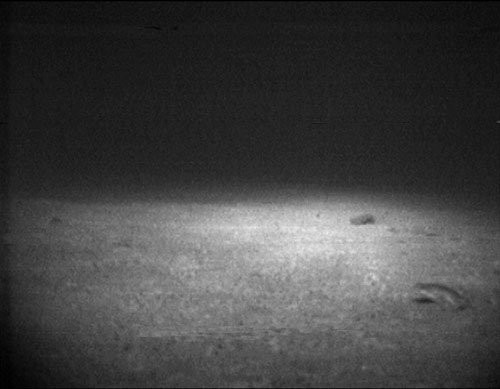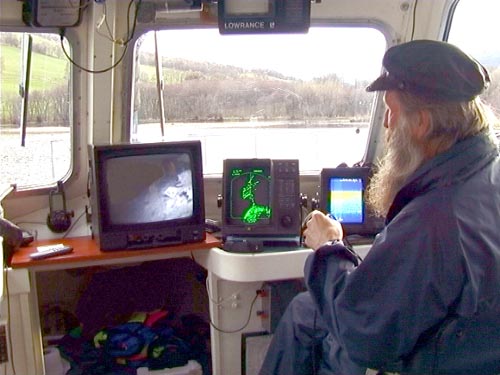
Copyright © Dick Raynor1975, 2001
Infra-red photograph of Loch Ness from beyond Fort Augustus

Copyright © Dick Raynor1975, 2001
Infra-red photograph of Loch Ness from beyond Fort Augustus
Bumble bees, according to the known laws of aerodynamics, should not be able to fly. Infra-red illumination, equally, should not work at all well underwater. Fortunately, bumble bees know as much about aerodynamics theory as I do about light transmission through liquids, and we both seem to get by.My interest in infra-red experiments started back in 1975 when I began taking photos on Kodak HIE High Speed Infra Red film. The picture above shows a view from the hill behind Fort Augustus looking down onto Loch Ness and the Great Glen. Material which reflects incident infra-red light creates a more exposed area, appearing pale or white in the positive print, while material which either absorbs the rays, or has none falling on it in the first place, is recorded as an unexposed area, dark or black in tone. In the picture the vegetation in the foreground has the sun shining on it, and reflecting the infra-red nicely back to the camera. Loch Ness itself, as one would expect, is very dark as it absorbs most of the radiation falling on it, and the hills along the sides of the loch, under a patch of cloudy sky, are also failing to reflect IR and therefore also appear dark.
Why on earth would anyone think of using IR illumination underwater? As a diver, I know that in sea water red light is the first to be absorbed, and the deeper one goes the darker and bluer it gets. Blue light penetrates further than any other "colour" in the sea.
But as a diver in Loch Ness, I know that the water is like a vat of fine whisky, with a delicate yellowish colour. As I go deeper in Loch Ness, the yellow surface light changes to orange, then golden brown, and finally greyish brown before I enter the zone of perpetual darkness at about 20 to 25 metres. In Loch Ness it seemed that red light goes further than any other visible colour, and on this basis I concluded that it was possible that infra-red light might penetrate better still.
The reasons for wishing to use IR is not so much for its penetrating powers, but for a hoped-for ability to see living creatures without them seeing my camera unit (or at least before they see it). What such creatures might be - well that would be for the future.

Copyright © Dick Raynor, 2001
Eel in soft sediment in infra-red lightThere are several ways to create infra-red illumination. An ordinary incandescent filament lamp produces lots of infrared radiation along with the visible range of wave-lengths, and one could simply filter out all but the IR using a suitable filter. This would however be extremely wasteful as well over 95% of the current passing down the cable would be wasted.
Another method is to use infra-red emitting diodes - the type which are found in the end of TV remote controllers - and although they only produce a few tens of millicandelas each, they are usable if you have a sufficiently sensitive tv camera. All tv cameras I have ever tested are sensitive to IR - check your own camcorder or security camera by pointing your tv remote into the lens and see the flashing white ( or blue, if in colour) light on the screen. The task is simply one of finding enough diodes and a sufficiently sensitive camera.
The eel picture above, taken in 2000, shows the result using only five diodes, while later experiments using a 50 diode cluster yield quite remarkable images. Work on fish behaviour is on-going, as seen in the photo below. Adrian Shine is shown operating the IRTV and the image from the bottom of the loch is on the monitor at the left hand side of the picture.

Copyright © Dick Raynor, 2001
Adrian Shine using IR TV on the Loch Ness Project vessel M.V.Deepscan, May 2001